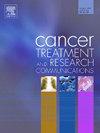阴囊佩吉特病患者来源异种移植物的建立和特征
IF 2.4
Q3 Medicine
引用次数: 0
摘要
目的建立阴囊佩吉特病(SPD)患者源性异种移植模型(PDX),为SPD治疗药物筛选和新药开发提供实验工具。方法将spd肿瘤组织植入雄性NOD-Scid小鼠右肩胛骨皮下,建立PDX模型。采用H&;E染色、免疫组织化学和PCR对PDX组织进行表征。通过患者肿瘤组织体外组织培养药敏试验(HDST)和PDX模型体内实验评估顺铂化疗的抗肿瘤作用。结果患者源性SPD组织在雄性NOD-Scid小鼠中具有致瘤性,并在连续传代后保持稳定。H&;E染色证实了患者肿瘤组织形态学特征的保存。免疫组化显示蛋白表达模式与临床表现一致。PCR排除自发性小鼠淋巴瘤。HDST实验显示患者肿瘤组织对顺铂敏感。体内实验表明,顺铂对SPD - PDX小鼠肿瘤生长有明显抑制作用,且不影响小鼠体重。结论成功建立SPD - PDX模型,PDX肿瘤保持了患者原肿瘤的特征。本文章由计算机程序翻译,如有差异,请以英文原文为准。
Establishment and characterization of patient-derived xenograft of scrotal Paget's disease
Objective
To develop a patient-derived xenograft model (PDX) of Scrotal Paget's disease (SPD), providing an experimental tool for the screening of therapeutic drugs and the development of new drugs for SPD treatment.
Methods
SPD tumor tissues were implanted into the subcutaneous area of the right scapula in male NOD-Scid mice to establish a PDX model. PDX tissues were characterized using H&E staining, immunohistochemistry, and PCR. Cisplatin chemotherapy's antitumor effects were assessed through ex vivo histoculture drug sensitivity test (HDST) with patient tumor tissues and in vivo experiments with the PDX model.
Results
The patient-derived SPD tissues were tumorigenic in male NOD-Scid mice and remained stable upon serial passage. H&E staining confirmed the preservation of morphological features from the patient's tumor tissues. Immunohistochemistry showed protein expression patterns consistent with clinical presentation. PCR ruled out spontaneous murine lymphoma. HDST experiments indicated cisplatin sensitivity in the patient's tumor tissues. In vivo experiments demonstrated significant tumor growth inhibition in SPD PDX mice with cisplatin, without affecting mouse body weight.
Conclusion
A SPD PDX model was successfully established, the PDX tumors maintained the characteristics of the patient’s original tumors.
求助全文
通过发布文献求助,成功后即可免费获取论文全文。
去求助
来源期刊

Cancer treatment and research communications
Medicine-Oncology
CiteScore
4.30
自引率
0.00%
发文量
148
审稿时长
56 days
期刊介绍:
Cancer Treatment and Research Communications is an international peer-reviewed publication dedicated to providing comprehensive basic, translational, and clinical oncology research. The journal is devoted to articles on detection, diagnosis, prevention, policy, and treatment of cancer and provides a global forum for the nurturing and development of future generations of oncology scientists. Cancer Treatment and Research Communications publishes comprehensive reviews and original studies describing various aspects of basic through clinical research of all tumor types. The journal also accepts clinical studies in oncology, with an emphasis on prospective early phase clinical trials. Specific areas of interest include basic, translational, and clinical research and mechanistic approaches; cancer biology; molecular carcinogenesis; genetics and genomics; stem cell and developmental biology; immunology; molecular and cellular oncology; systems biology; drug sensitivity and resistance; gene and antisense therapy; pathology, markers, and prognostic indicators; chemoprevention strategies; multimodality therapy; cancer policy; and integration of various approaches. Our mission is to be the premier source of relevant information through promoting excellence in research and facilitating the timely translation of that science to health care and clinical practice.
 求助内容:
求助内容: 应助结果提醒方式:
应助结果提醒方式:


